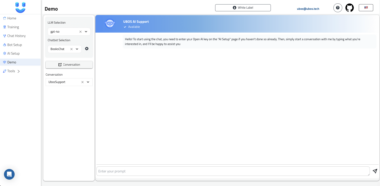Frequently Asked Questions (FAQ) about DocsRay
Q: What is DocsRay?
A: DocsRay is a lightweight PDF Question-Answering (Q&A) tool powered by Retrieval-Augmented Generation (RAG) with MCP (Model Context Protocol) Support. It allows you to ask questions about your PDF documents and get accurate, context-aware answers.
Q: What file types does DocsRay support?
A: DocsRay supports over 30 file formats including Microsoft Office documents (.docx, .xlsx, .pptx), plain text (.txt), image formats (.jpg, .png, .gif, .bmp, .tiff, .webp), HTML, and Markdown. It automatically converts these formats to PDF for processing.
Q: How do I install DocsRay?
A: You can install DocsRay using pip:
bash pip install docsray
Q: How do I download the required models for DocsRay?
A: You can download the models using the following command:
bash docsray download-models
Q: How do I start the web interface?
A: You can start the web interface using the following command:
bash docsray web
Q: What is MCP Integration?
A: MCP (Model Context Protocol) integration allows DocsRay to seamlessly integrate with Claude Desktop and other MCP-compatible AI models, enabling contextual interaction with your documents directly from these platforms.
Q: How do I configure Claude Desktop for MCP integration?
A: You can configure Claude Desktop using the following command:
bash docsray configure-claude
Q: What are the different performance modes in DocsRay?
A: DocsRay has three performance modes: FAST_MODE, Standard, and FULL_FEATURE_MODE. The mode is automatically selected based on your system’s resources, but you can force a specific mode using the DOCSRAY_FAST_MODE environment variable.
Q: What models does DocsRay use?
A: DocsRay uses models such as bge-m3, multilingual-e5-large, Gemma-3-1B, and Gemma-3-4B for embedding and answer generation.
Q: How much storage space do the models require?
A: The models require approximately 8GB of storage space in total.
Q: How do I clear the cache in DocsRay?
A: You can clear the cache using the clear_all_cache MCP command or by manually deleting the contents of the cache directory (~/.docsray/cache/).
Q: Does DocsRay support visual content analysis?
A: Yes, DocsRay supports visual content analysis using models like Gemma-3-4B. It can analyze images, charts, and diagrams within your documents.
Q: How do I enable or disable visual analysis?
A: You can enable or disable visual analysis through the web interface or by adjusting the analyze_visuals parameter in the Python API.
Q: How does the auto-restart feature work?
A: DocsRay includes an automatic restart feature that helps maintain service stability by automatically recovering from errors, memory issues, or crashes. Use the --auto-restart flag when starting the web or MCP server.
Q: What is the FAST_MODE and when should I use it?
A: FAST_MODE is an optimized mode for resource-constrained environments. It reduces memory usage and processing time by using lower-precision models and disabling certain features like visual analysis. Use it when running DocsRay on laptops or servers with limited resources.
Q: How can DocsRay be integrated with the UBOS platform?
A: DocsRay can be integrated with UBOS to enhance AI Agent development and deployment. It can be easily incorporated into UBOS-managed AI Agents, improving their ability to understand and interact with documents. UBOS also simplifies the deployment and management of DocsRay in a business environment.
DocsRay
Project Details
- MIMICLab/DocsRay
- MIT License
- Last Updated: 6/13/2025
Recomended MCP Servers

mcp server for cloudflare flux schnell worker api.
An MCP server for Raindrop.io

Omnisend MCP server
An MCP Server and sample client for Selector AI
A MCP server for automated website deployment to 1Panel (Experimental)


Model Context Protocol server for querying Cursor chat history
 From vibe coding to vibe deployment. UBOS MCP turns ideas into infra with one message.
From vibe coding to vibe deployment. UBOS MCP turns ideas into infra with one message.






